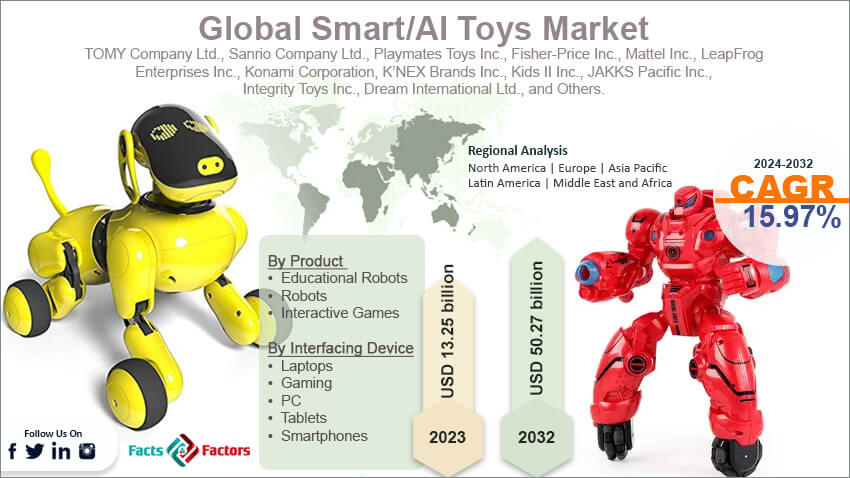Search Market Research Report
Smart/AI Toys Market Size, Share Global Analysis Report, 2024 – 2032

Smart/AI Toys Market Size, Share, Growth Analysis Report By Distribution Channel (Offline And Online Channels), By Product (Educational Robots, Robots, And Interactive Games), By Interfacing Device (Laptops, Gaming, PC, Tablets, Smartphones, And Others), By Application (Educational, Entertainment, And Others), By Technology (Bluetooth, WiFi, And Others), And By Region - Global and Regional Industry Insights, Overview, Comprehensive Analysis, Trends, Statistical Research, Market Intelligence, Historical Data and Forecast 2024 – 2032
Industry Insights
[218+ Pages Report] According to Facts and Factors, the global smart/AI toys market size was valued at USD 13.25 billion in 2023 and is predicted to surpass USD 50.27 billion by the end of 2032. The smart/AI toys industry is expected to grow by a CAGR of 15.97% between 2024 to 2032.

 Market Overview
Market Overview
Smart toys are based on machine intelligence with interactive features. These are designed to engage children with playing and learning activities. These toys work on AI algorithms to mimic human-like responses. Also, AI toys are well equipped with connectivity features like Bluetooth and WiFi for better functionality.
 Key Insights
Key Insights
- As per the analysis shared by our research analyst, the global smart/AI toys market size is estimated to grow annually at a CAGR of around 15.97% over the forecast period (2024-2032).
- In terms of revenue, the global smart/AI toys market size was valued at around USD 13.25 billion in 2023 and is projected to reach USD 50.27 billion by 2032.
- Growing emphasis on education is driving the growth of the global smart/AI toys market.
- Based on the end-user, the online channel segment is growing at a high rate and is projected to dominate the global market.
- Based on the products, the educational robots segment is projected to swipe the largest market share.
- Based on the materials, the smartphone segment is projected to witness a high CAGR during the forecast period.
- Based on region, North America is expected to dominate the global market during the forecast period.

 Growth Drivers
Growth Drivers
- Growing emphasis on education is driving the growth of the global market.
The increasing focus of people all across the globe on promoting education among children is one of the primary factors driving the growth of the global smart/AI toys market. The growing initiatives to promote education are widening the scope for smart toys in the market. The educational toys foster STEM (Science, Technology, Engineering, Mathematics) education among children. This education system builds the required skills and cognitive abilities in children.
Also, technological advancements are supporting the growth of the industry. Manufacturers are coming up with advanced smart toys to help parents and children have improved experiences. For instance, Leapfrog Enterprises unveiled the new arrivals in their newborn and preschool product portfolio in 2023. Also, one of the toys from their collections was nominated for the Toy of the year award.
 Restraints
Restraints
- Privacy concerns are likely to hamper the growth of the global market.
The use of personal data by smart toys fosters privacy issues among people, which is likely to slow down the growth of the smart/AI toys industry. Moreover, the strict regulations and rising awareness among people regarding the security of sensitive data are further likely to hinder the growth of the industry.
 Opportunities
Opportunities
- Rising digital connectivity is expected to foster growth opportunities in the global market.
The proliferation of tablets, smartphones, and other digital devices is widening the scope of the global smart/AI toys market. There is an emerging demand for digital connectivity in the market. People are looking forward to integrating their mobile devices with every device for control, interactivity, synchronization, and access to additional content. Therefore, such a landscape is expected to propel the growth of the smart/AI toys industry.
For instance, Mattel Inc. partnered with Hasbro Inc. to come up with Barbie robotics engineering facilities in the global marketplace. It was built to offer free six coding lessons to kids intellectually.
 Challenges
Challenges
- High cost is a big challenge in the global market.
Smart toys are a little expensive because of the inclusion of advanced technology and devices. However, this advanced machine has high retail prices, which deters price-sensitive customers and thereby limits the growth of the smart/AI toys industry.
 Segmentation Analysis
Segmentation Analysis
The global smart/AI toys market can be segmented into distribution channel, product, interfacing device, application, technology, and region.
On the basis of distribution channels, the market can be segmented into offline and online channels. The online channel segment accounts for the largest share of the smart/AI toys industry. The growing popularity of online retailing channels is propelling the growth of the segment. Also, these online channels offer a wider customer reach, and therefore, manufacturers are looking forward to online retailing activities, which even help them overcome geographical limitations.
Also, these channels offer attractive deals, discounts, and convenience, which attract consumers to purchase the products online. Many online platforms like Amazon and Alibaba are expected to revolutionize the market in the coming years. Online platforms have dedicated sections for each product, like electronics and education.
Moreover, people can compare the products online by extracting extensive product information from different sites. Also, consumers can get customer reviews and make their purchasing decisions accordingly. Therefore, such a landscape is expected to fuel the growth of the segment in the coming years.
On the basis of product, the market can be segmented into educational robots, robots, and interactive games. Educational robots are the fastest-growing segment in the global smart/AI toys market. Educational robots are increasingly being adopted in educational institutions and school programs to develop competitiveness and interactive sessions among children. Educational institutes are highly integrating robotic systems into the curriculum, which is likely to boost the demand in the market.
The educational centers are adopting these robots to enhance the learning environment and offer comprehensive teaching to children. Robots make complex concepts more enjoyable to students, thereby initiating experiment based learning, which is a hands-on approach to delivering better education for future generations. All these aspects are expected to accentuate the growth of the segment significantly during the forecast period.
On the basis of interfacing devices, the market can be segmented into laptops, gaming, PCs, tablets, smartphones, and others. The smartphone segment is expected to witness significant growth during the anticipated period. One of the major reasons propelling the growth of the segment is the emergence of 5G technology. Smartphone manufacturers are coming up with improved devices to attract customers. Innovative designs, form factor elements, and display cameras boost the popularity of smartphones in the market. The increasing affordability and accessibility of smartphones are also expected to positively impact the growth trajectory of the segment during the period.
On the basis of application, the market can be segmented into educational, entertainment, and others. The education segment is poised to witness huge growth in the forthcoming years. The rising trend of integrating technology in education is one of the major reasons for the high growth of the segment. Another factor influencing the segment’s growth is the advantages of these AI toys in fostering skills like creativity, problem-solving, and critical thinking among children.
Additionally, the emergence of smart toys with an emphasis on STEM education is further increasing their popularity in the market. The advent of remote learning is also widening the scope of virtual education. Parents nowadays are looking forward to buying educational toys which can support their children’s learning.
However, the availability of personalized learning features to adapt to individual bases and preferences is further attracting parents. However, these features improve the effectiveness of educational content delivery, which is a crucial factor impacting the growth of the segment.
On the basis of technology, the market can be signed into Bluetooth, WiFi, and others. The WiFi segment is poised to witness a high CAGR in the coming years. WiFi connectivity helps manufacturers remotely upgrade their content and software at regular intervals. This is an important feature for both the manufacturers and parents to stay up-to-date with the new content and technology.
Also, the emergence of cloud-based services is expected to boost the growth of the segment. These services help people personalize and synchronize the content across multiple devices. WiFi connectivity offers important features like parental control, which helps people manage their children's interactions with toys to ensure the delivery of the right content to them.
 Report Scope
Report Scope
Report Attribute |
Details |
Market Size in 2023 |
USD 13.25 Billion |
Projected Market Size in 2032 |
USD 50.27 Billion |
CAGR Growth Rate |
15.97% CAGR |
Base Year |
2023 |
Forecast Years |
2024-2032 |
Key Market Players |
TOMY Company Ltd., Sanrio Company Ltd., Playmates Toys Inc., Fisher-Price Inc., Mattel Inc., LeapFrog Enterprises Inc., Konami Corporation, K’NEX Brands Inc., Kids II Inc., JAKKS Pacific Inc., Integrity Toys Inc., Dream International Ltd., and Others. |
Key Segment |
By Distribution Channel, By Product, By Interfacing Device, By Application, By Technology, and By Region |
Major Regions Covered |
North America, Europe, Asia Pacific, Latin America, and the Middle East &, Africa |
Purchase Options |
Request customized purchase options to meet your research needs. Explore purchase options |
 Regional Analysis
Regional Analysis
- North America to dominate the global market.
North America has the largest share of the global smart/AI toys market during the forecast period. The region is the early adopter of new technologies, and therefore, it is expected to be the major market for the industry. Also, people in the region are more enthusiastic and interested in new technologies. The market in the region is highly competitive because of the established tech companies in the region. The region is a hub for technological innovation and is expected to be a major driver for the growth of the regional market.
Also, the increasing number of toys in departmental stores and online retailers in the region is further boosting the popularity of AI toys.Asia Pacific is also likely to see a steady growth rate in the coming years because of its diverse population. Also, the increasing population of kids in the region is emerging as a major factor accentuating the demand.
Moreover, the growing middle-class population, along with their disposable income, is also likely to support the growth trajectory of the regional market. Also, the surging emphasis of people on education in the region is boosting the demand for educational robotics and other smart toy markets.
 Competitive Analysis
Competitive Analysis
The key players in the global smart/AI toys market include:
- TOMY Company Ltd.
- Sanrio Company Ltd.
- Playmates Toys Inc.
- Fisher-Price Inc.
- Mattel Inc.
- LeapFrog Enterprises Inc.
- Konami Corporation
- K’NEX Brands Inc.
- Kids II Inc.
- JAKKS Pacific Inc.
- Integrity Toys Inc.
- Dream International Ltd.
For instance, Mattel Inc. came up with new updates in their virtual collectibles platform in 2023. The company has offered a peer-to-peer marketplace through this platform.
The global smart/AI toys market is segmented as follows:
 By Distribution Channel Segment Analysis
By Distribution Channel Segment Analysis
- Offline
- Online Channels
 By Product Segment Analysis
By Product Segment Analysis
- Educational Robots
- Robots
- Interactive Games
 By Interfacing Device Segment Analysis
By Interfacing Device Segment Analysis
- Laptops
- Gaming
- PC
- Tablets
- Smartphones
- Others
 By Application Segment Analysis
By Application Segment Analysis
- Educational
- Entertainment
- Others
 By Technology Segment Analysis
By Technology Segment Analysis
- Bluetooth
- WiFi
- Others
 By Regional Segment Analysis
By Regional Segment Analysis
- North America
- The U.S.
- Canada
- Mexico
- Europe
- France
- The UK
- Spain
- Germany
- Italy
- Rest of Europe
- Asia Pacific
- China
- Japan
- India
- Australia
- Southeast Asia
- Rest of Asia Pacific
- The Middle East & Africa
- Saudi Arabia
- UAE
- Egypt
- Kuwait
- South Africa
- Rest of the Middle East & Africa
- Latin America
- Brazil
- Argentina
- Rest of Latin America
Industry Major Market Players
- TOMY Company Ltd.
- Sanrio Company Ltd.
- Playmates Toys Inc.
- Fisher-Price Inc.
- Mattel Inc.
- LeapFrog Enterprises Inc.
- Konami Corporation
- K’NEX Brands Inc.
- Kids II Inc.
- JAKKS Pacific Inc.
- Integrity Toys Inc.
- Dream International Ltd.
Frequently Asked Questions

Copyright © 2024 - 2025, All Rights Reserved, Facts and Factors


